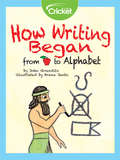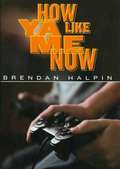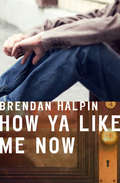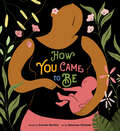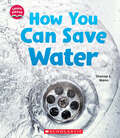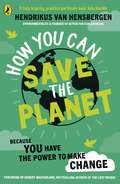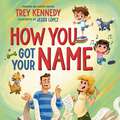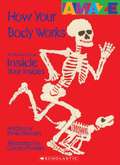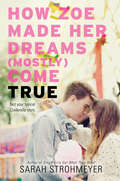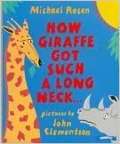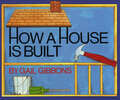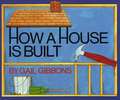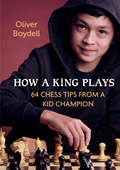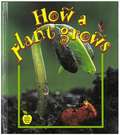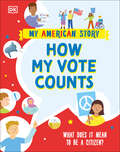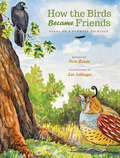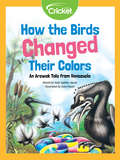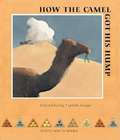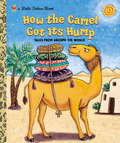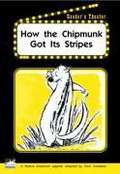- Table View
- List View
How Writing Began: From Apple to Alphabet
by John GranditsA long time, humans did not have writing. At some point, people began using symbols and then pictures.
How Ya Like Me Now
by Brendan HalpinAfter his father dies and his mother goes into rehab, Eddie moves from the suburbs into his cousin's Boston loft, where he gradually adjusts to being one of the few white kids in a progressive school, and learns how to feel like a normal teenager.
How Ya Like Me Now
by Brendan HalpinSince his dad died, Eddie's mom has spent all her time getting high on OxyContin, leaving Eddie to take care of himself. When Eddie's mom goes into rehab and his aunt and uncle take him away to Boston, everything changes. His new school, which he attends with his cousin Alex, is experimental: there's a CEO instead of a principal, classes are held in an office building, and the students, all sporting business-casual looks, are the only urban kids Eddie has ever seen outside of a rap video. As for Alex, it's bad enough that he has to share his bedroom with Eddie, but his parents are on his case about including his quiet cousin in his social life as well. Alex wants to do the right thing, but between talking to girls, playing video games, thinking about girls, laughing with his friends, and looking at girls, when is he supposed to find time to help Eddie and "work up to his potential" in school? Two boys find that they have a lot to learn from each other in this touching, funny novel about finding your place and looking out for your friends.
How You Came to Be
by Carole GerberThis love letter written from mother to child invites readers to experience a baby's month-by-month development in the womb as compared to familiar fruits and vegetables.A mother lovingly describes the sizes and stages of her baby's month-by-month development inside the womb, and the amazement of experiencing it from the outside. Look at you - as big as a banana! Some of your cells formed into bones,and your arms and legs grew longer.I could feel you kick!Sometimes when I rubbed my belly,I felt you thump back. Was that your way of saying hello?Simple, age-appropriate facts are woven into a tender and lyrical text that celebrates the miracle of a baby. It demystifies and informs readers, while simultaneously appreciating the wonder of it all. A perfect read-aloud for mother and child, or for children whose mothers are pregnant with a younger sibling.
How You Can Save Water (Learn About)
by Dionna L. MannAn essential tool to teach kids about the importance of water!Did you know that when water appears in your home, it must disappear from somewhere else? And that freshwater supply has to be shared by 7.7 billion people on Earth? If people do not conserve freshwater, there will not be enough for everyone. The good news is that there are lots of ways you can help save water. Learn all about them in How You Can Save Water.ABOUT THIS SERIES: Earth is known as the Blue Planet because of the abundant amount of water that covers our home. And nothing on Earth could survive without it. As we find ourselves facing a global water crisis, learning about this life-giving resource has never been more important. The books in this series are filled with colorful photos and diagrams, plus easy-to-digest text, and fascinating facts. And they offer young readers an in-depth look at what water is, how we use it, and most importantly, what we can do to protect it.
How You Can Save the Planet
by Hendrikus van Hensbergen*Foreword by Robert Macfarlane, bestselling author of The Lost Words.*If you're worried about climate change, this book is an essential and reassuring read.We often feel like we don't have the power to make real change.But our small changes can add up to something BIG. Packed with reassuring step by step actions and easy to follow DIY activities, How You Can Save The Planet is the perfect gift for young activists who want to make a difference.With simple explanations, practical tips and stories from children across the world, this guide is ideal for young people who are worried about climate change and want to help our planet!Crafted by Hendrikus van Hensbergen, whose work is featured on BBC Bitesize[JP2] , this inspiring read is perfect for children at KS2. 'Every young person in the country should be given this book' Sir Tim Smit, Founder of The Eden Project'It's enlightening, inspiring and empowering' Kate Humble, TV presenter'Wonderfully informative, fun and practical [. . .] A great source of inspiration' The Rich Brothers, TV presenters
How You Got So Smart
by David MilgrimEvery stage in growing up has its own fun and challenges, and the adorable star of this book faces each one with gusto. As a baby, there's the taste-everything phase--whether it is meant to be eaten or not! And as a toddler, there's the question-everything phase. But all the while baby is growing up and becoming a curious kid whose exploration of the world leads to amazing places and discoveries. He's come so far and learned so much, and now everyone is so proud of him! This celebration of curiosity and creativity, with its funny, joyful illustrations full of kid-friendly details, is a great gift for any major milestone.
How You Got So Smart
by David MilgrimIn this book the author uses a little boy to so kids how they grow and become smart young people. This is a book that boost kids confidence, he says things like "you studied the sounds" and has a picture of a baby throwing thing on the floor. My kids reaction to this particular page was, he's making a mess. This is a good book to read to kids who feel like they aren't as smart as other kids to boost their confidence.
How You Got Your Name
by Trey KennedyFrom comedian and viral content sensation Trey Kennedy comes How You Got Your Name, a hilarious and touching book celebrating the wild journey to each child's name and the meaningful story behind it.When one little guy asks his parents about how they chose his name, he's in for a wild ride! Readers will giggle at the silly names the parents in the story almost picked as they're inspired by everything around them, including playground equipment, the foods in the grocery store, and cell phone sounds. The funny and sweet story ends with a beautiful reminder for kids that God knows their name too.With vibrant illustrations, this jacketed picture bookis for boys and girls, ages 4 to 8;gives readers a chance to guess the character's name, making each reading experience memorable and laugh-out-loud funny;includes space for parents to fill out the real story behind their child's name, making this book a wonderful keepsake for the whole family; andis a perfect gift for baby showers and birthdays and for showing your child just how much thought and love went into their name.With its lighthearted tone and prompts for readers to share silly name ideas, How You Got Your Name is a delightful read for families to enjoy together.
How Your Body Works: A Good Look Inside Your Insides
by David StewartWhat, Why, and How is explained with respect to human body.
How Zoe Made Her Dreams (Mostly) Come True
by Sarah StrohmeyerWhen cousins Zoe and Jess land summer internships at Fairyland Kingdom theme park, they are sure they've hit the jackpot. With perks like hot Abercrombie-like Prince Charmings and a chance to win the coveted $25,000 Dream & Do grant, what more could a girl want? Once Zoe arrives, however, she's assigned to serve the Queen—Fairyland's boss from hell. From spoon-feeding the Queen's evil lapdog caviar to fetching midnight sleeping tonics, Zoe fears she might not have what it takes to survive the summer, much less win the money. Soon backstabbing interns, a runaway Cinderella, and cutthroat competition make Zoe's job more like a nightmare than a fairy tale. What will happen when Zoe is forced to choose between serving the Queen and saving the prince of her dreams?
How a City Works (Let's-Read-and-Find-Out Science 2)
by D. J. WardRead and find out about how cities work in this colorfully illustrated nonfiction picture book.Millions of people live in cities around the world, but have you ever wondered how cities work? All those people need clean water to drink, a safe place to live, and a way to get all around the city. How do you take care of all those people’s needs? Read and find out all about the systems a city has to help keep everyone safe, healthy, and happy.This book on city systems will appeal to the young civil engineer. How a City Works is filled with fun, accurate art, and includes tons of information. For example, it answers the question: Where does all the electricity needed to make a city run come from? How a City Works covers water treatment, power, sewage, recycling, and transportation.How a City Works comes packed with visual aids like charts, sidebars, an infographic, and a funny, hands-on activity—how to clean up dirty “sewage” water, using puffed rice cereal, raisins, hot chocolate mix, and coffee filters.This is a clear and appealing science book for early elementary age kids, both at home and in the classroom. It's a Level 2 Let's-Read-and-Find-Out, which means the book explores more challenging concepts for children in the primary grades. The 100+ titles in this leading nonfiction series are:hands-on and visualacclaimed and trustedgreat for classroomsTop 10 reasons to love LRFOs:Entertain and educate at the same timeHave appealing, child-centered topicsDevelopmentally appropriate for emerging readersFocused; answering questions instead of using survey approachEmploy engaging picture book quality illustrationsUse simple charts and graphics to improve visual literacy skillsFeature hands-on activities to engage young scientistsMeet national science education standardsWritten/illustrated by award-winning authors/illustrators & vetted by an expert in the fieldOver 130 titles in print, meeting a wide range of kids' scientific interestsBooks in this series support the Common Core Learning Standards, Next Generation Science Standards, and the Science, Technology, Engineering, and Math (STEM) standards. Let's-Read-and-Find-Out is the winner of the American Association for the Advancement of Science/Subaru Science Books & Films Prize for Outstanding Science Series.
How a Comic Book is Made (Fountas & Pinnell LLI Red #Level P)
by Michael SandlerPeople around the world love colorful, action-packed comic books. Find out who makes comic books, and how they do it.
How a Giraffe got such a long neck: A Tale From East Africa
by Michael RosenVersions of this story are told in many parts of East Africa. Similar tales are told by the Kikuyu and Masai tribes in Kenya and by tribes in Southern Africa. This version has been adapted by permission of Nick Greaves from an East African folktale that appears in When Hippo Was Hairy (DavidBateman Ltd. New Zealand, 1988). The artist has based his depiction of Man on early Masai tribesmen.
How a House Is Built
by Gail GibbonsHouses are built with many different materials, and in many shapes and sizes. Step by step, this picture book explains how homes are built—from the architect's plans through the arrival of a happy family. The many processes of construction are explained with simple language and bright, clear illustrations, perfect for kids starting to wonder about how the world around them works. Many different careers—including carpenters, plumbers, electricians, and landscapers—are introduced, each doing their part to bring the picture wood-frame house to life. A great read for kids who love construction sites, or who can't get enough of Building a House by Byron Barton. According to The Washington Post, Gail Gibbons "has taught more preschoolers and early readers about the world than any other children's writer-illustrator." Ms. Gibbons is the author of more than 100 books for young readers, including the bestselling titles From Seed to Plant and Monarch Butterfly. Her many honors include the Washington Post/Childrens Book Fuild Nonfiction Award and the NSTA Outstanding Science Trade Book Award.
How a House is Built
by Gail GibbonsGail Gibbons uses clear, simple wording to present all the steps involved in building a house. From the architect who draws the plans, through the various types of workers who construct it, to the family who will make the house their home, each aspect is explained. Children can easily follow along as construction begins at the ground level with surveyors, describing the jobs of carpenters and plumbers. The many tools used to complete each task are explained, ultimately showing how all the workers' efforts come together to build a whole house from basement to roof, both inside and outside.
How a King Plays: 64 Chess Tips from a Kid Champion
by Oliver BoydellFor fans of The Queen's Gambit comes a brand-new book from 11-year-old chess champion Oliver Boydell. How a King Plays features 64 of Boydell's tips, strategies, and ideas to help chess enthusiasts of all ages sharpen their game skills.Whether you're new to chess or a Grandmaster, there's something for everyone in chess phenom Oliver Boydell's new book of 64 chess tips, How a King Plays. At only 11-years-old, Boydell has already been both a National Chess Champion and a New York City Chess Champion who's competed at numerous major scholastic chess events since he started playing at the age of 5. Now, Boydell is lending his talents to the page as he shares some of his best tips that helped him become a star. Written in his signature concise and witty voice, Boydell offers players of all levels—from beginners to advanced—a different, creative tip on every page. An introduction from the author, inspirational quotes from chess greats, and a glossary of terms help round out this comprehensive and informative, fun guide. Jam-packed with wisdom and imaginative gameplay, this compact and portable reference book can easily be taken on the go to a tournament, to the park, or anywhere you're traveling. How a King Plays is the ideal companion for anyone whose passion for chess can't be contained.
How a Seed Grows (Let's-Read-and-Find-Out Science 1)
by Helene J. JordanRead and find out about how a tiny acorn grows into an enormous oak tree in this colorfully illustrated nonfiction picture book.This is a clear and appealing environmental science book for early elementary age kids, both at home and in the classroom. Plus it includes a find out more activity section with a simple experiment encouraging kids to discover what a seed needs to grow.This is a Level 1 Let's-Read-and-Find-Out, which means the book explores introductory concepts perfect for children in the primary grades. The 100+ titles in this leading nonfiction series are:hands-on and visualacclaimed and trustedgreat for classroomsTop 10 reasons to love LRFOs:Entertain and educate at the same timeHave appealing, child-centered topicsDevelopmentally appropriate for emerging readersFocused; answering questions instead of using survey approachEmploy engaging picture book quality illustrationsUse simple charts and graphics to improve visual literacy skillsFeature hands-on activities to engage young scientistsMeet national science education standardsWritten/illustrated by award-winning authors/illustrators & vetted by an expert in the fieldOver 130 titles in print, meeting a wide range of kids' scientific interestsBook in this series support the Common Core Learning Standards, Next Generation Science Standards, and the Science, Technology, Engineering, and Math (STEM) standards. Let's-Read-and-Find-Out is the winner of the American Association for the Advancement of Science/Subaru Science Books & Films Prize for Outstanding Science Series.
How a plant grows (Crabapples)
by Bobbie KalmanHow A Plant Grows introduces children to the amazing lives of plants--from their beginnings, through their growth, to reproduction and death. Full-color illustrations and photographs accompany simple plant experiments.
How my Vote Counts: What does it mean to be a Citizen? (My American Story)
by DKInspires young learners to explore rights and responsibilities of citizens through the nation&’s history and the experience of modern AmericansPart of an inspiring series of books that will support students to understand government and civics in modern America through the historical events and people that have shaped them, My Vote Counts will interweave historical context, events and personalities with the experiences of modern Americans to help students understand key social studies topics including the origins of American institutions and values and their relevance to young people&’s lives today.The book explores what it means to be a citizen of the USA, with a focus on both rights and responsibilities of citizens and political involvement, ways of obtaining citizenship. Historical topics / events covered include Colonial era, Bill of Rights (equal rights of citizens), slavery, Civil War and emancipation, participation in elections, immigration.
How the Birds Became Friends
by Noa BaumA playful picture book with a powerful message from a national storyteller. With each bird desperate to prove himself superior to the others, can little Quail break the cycle with an act of kindness?
How the Birds Changed Their Colors
by Gale Sypher Jacob Gary FasenHow did some birds come to have brightly colored feathers to match the flowers and fruits of the tropical forest, but others stayed in muted colors? According to this Arawak folktale, they got their colors from a snake! What happens when there aren’t enough colors to go around?
How the Camel Got His Hump
by Rudyard Kipling Lisbeth ZwergerWhen the world was new, Man needed help from all the animals, but when he received complete refusal from the camel, the rest of the animals turned to Djinn of all the Deserts to seek a proper punishment for his lazy behavior.
How the Camel Got Its Hump (Little Golden Book)
by Justine Fontes Ron Fontes Keiko MotoyamaWitty stories from around the world, and by the great writer Rudyard Kipling, "explain" how the camel got its hump. Fascinating facts about the camel round out this colorful book!
How the Chipmunk Got Its Stripes
by Jackie Urbanovic Pam Hirschfeld Staci SwedeenPerform this script about a Native American legend about how a chipmunk got its stripes.
